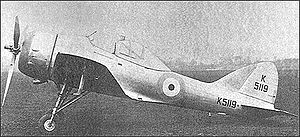Bristol Type 146 Video - Picture

|
|
Bristol Type 146
Type 146

Picture - Bristol 146, c. 1938
Role: Single-seat fighter
National origin: United Kingdom
Manufacturer: Bristol Aeroplane Company
First flight: 11 February 1938
Number built: 1
The Bristol Type 146 was a British single-seat, eight-gun fighter monoplane prototype built to a mid-1930s Air Ministry contract. Powered by a radial engine, it was outclassed by Merlin-engined fighters and only one was built.
Design and development
The Bristol 146 was built by Bristol to an Air Ministry order for a prototype single-seat eight-gun fighter meeting Air Ministry specification F.5/34 issued in 1934. The specification further called for an air-cooled engine for overseas use. The Type 146 incorporated the experience of metal-skinned monoplanes that Bristol had gained with the earlier Type 133, but was quite different in detail.
The Type 146 embodied a low-wing cantilever monoplane with tapering wings that carried moderate dihedral on the outer sections. The wings were stress skinned with aluminium with only the ailerons and tail control surfaces fabric-covered. The two pairs of four 0.303 in (7.7 mm) Browning machine guns were housed in the outer wing sections. The undercarriage was mounted about half way along the centre section and retracted cleanly inwards into the wing root; the tail wheel was also fully retractable. In contrast to the Type 133, the entire fuselage was a monocoque structure. The cockpit was enclosed with a one-piece sliding canopy.
The Type 146 was designed to be powered by a supercharged Bristol Perseus sleeve valved radial engine, but this was not ready and Bristol's older design the Bristol Mercury IX radial was used instead.
Testing
The Type 146 flew for the first time on 11 February 1938 in the hands of Cyril Uwins and was flight tested satisfactorily before going on to be assessed against the F.5/34 specification by the Aeroplane and Armament Experimental Establishment at RAF Martlesham Heath in April 1938. Its competitors there were the Gloster F.5/34, the Martin-Baker MB2 and the Vickers Venom.
Though the Type 146 met the specification neither it nor any of the other competing designs was taken into production. The RAF believed that the future of British fighter design was with the emerging Rolls-Royce Merlin-engined aircraft (Specification F.36/34) which had more power and cleaner aerodynamics. The second Type 146 prototype was cancelled, while K5119 continued to fly.
On 28 May 1938, following an Empire Air Day display at Filton Aerodrome, the sole Type 146 while taxying, struck a "set-piece" display and was damaged beyond economic repair. It was the last single-engined fighter to be built by Bristol.
Specifications
Data from Barnes 1970, p. 266
General characteristics
Crew: 1
Length: 27 ft 0 in (8.23 m)
Wingspan: 39 ft 0 in (11.89 m)
Height: 10 ft 4 in (3.15 m)
Wing area: 220 ft² (20.44 m²)
Empty weight: 3,283 lb (1,490 kg)
Gross weight: 4,600 lb (2,087 kg)
Powerplant: 1 x— Bristol Mercury IX 9-cylinder single-row radial engine, 840 hp (626 kW)
Performance
Maximum speed: 287 mph (462 km/h)
Service ceiling: 38,100 ft (11,613 m)
Armament
8 x— 0.303 in (7.7 mm) Browning machine guns
Andrews, CF; Morgan, E.B. (1988). Vickers Aircraft since 1908 (2nd ed.). London: Putnam. ISBN 0 85177 815 1.
Barnes, C.H. (1970). Bristol Aircraft since 1910. London: Putnam Publishing. ISBN 0 370 00015 3.
"Bristol 146." Control Column, Official Organ of the British Aircraft Preservation Council, Volume 12, No. 6, August/September 1978.
Bristol Type 146 Pictures
Living Warbirds: The best warbirds DVD series.
Source: WikiPedia